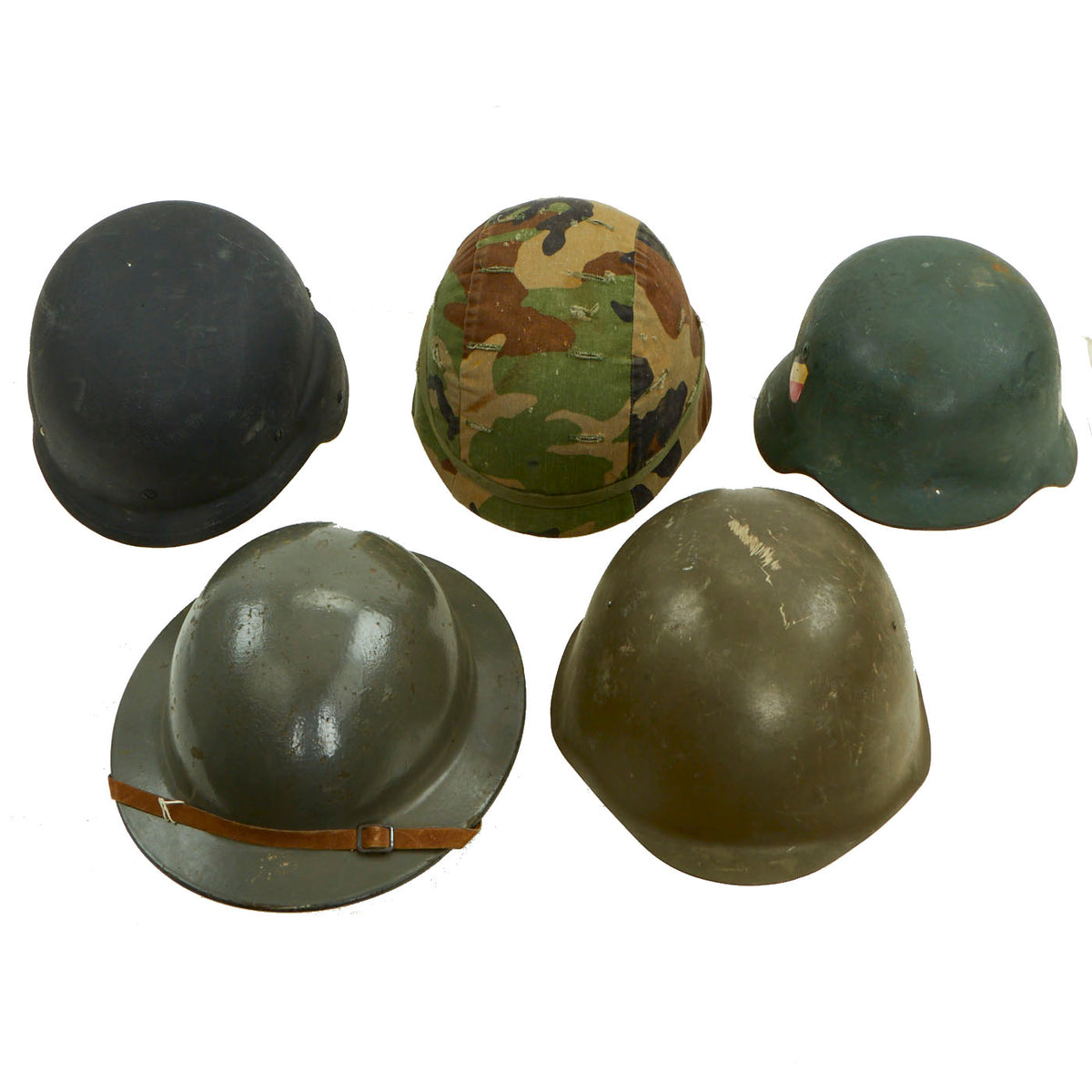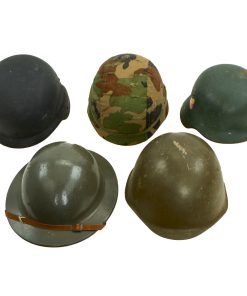Original American & European Cold War Era Helmet Lot – 5 Items Original Items
$ 225,00 $ 90,00
Original Items: Only One Set Available. This is a very nice collection of helmets from various time periods and countries. All helmets are complete with liners and are offered in great condition. This is a wonderful lot to pick up if you are looking to either start collecting helmets or are just wanting to add these really nice examples to your already existing ones.
The following five helmets are included in this lot:
– German Bundesgrenzschutz M-53 helmet: This appears to be a BGS M53 helmet, but it was been rather difficult to identify. The helmet was done up to look like a WW2 era Kriegsmarine M40, complete with decals. The helmet is in good condition with the front brim a little bent. With some cleaning and paint removal this helmet would be perfect.
– Czechoslovakian Vz.52 Helmet: The Czechoslovakian M52 helmet was used by the Czechoslovak Army from the early 1950s onward. In western European countries and the United States, it is sometimes referred to as the Czech M53 helmet. These helmets are commonly mistaken for, and sometimes marketed as, Soviet SSh-40 helmets, and various other very similar Eastern Bloc helmets. As military souvenirs, Vz. 52 helmets may be marketed online as a ‘Soviet WW2 Helmet’ to appeal to consumers more.
Although the Soviet SSh-39 and SSh-40 helmet shells do look similar to a Vz. 52, there are many ways to tell them apart. On a Czech Vz. 52 or any other variant of the Vz. 52 there should be a stamp of two crossed swords on the inside of the front of the helmet. This is the Czechoslovak seal of approval. Right next to that is a two-digit number indicating the year it was manufactured. For example, this one is 52 for 1952. Directly below is a number 1, 2, or 3 indicating the size of the helmet. This is a size 1.
– Brodie Helmet Clone: This brodie helmet is currently unidentified. We have not been able to find another like it. It appears to possibly be a Civil Defense type helmet. There are webbing bales welded to the skirt and has a leather M1 Helmet style sweatband. Perfect research opportunity.
– Medium PASGT American Helmet: The helmet is in lovely condition with the earlier style suspension and webbing system. We have not taken off the cover but there appears to be a crack in the Kevlar on the front. All internal components are complete and the helmet is without a chin strap.
– Large PASGT American Helmet: Another lovely example of the helmet known simply as a kevlar amongst American troops. The helmet has been painted black, more than likely for police use. There is no sweatband, only the suspension webbing and chin strap remain.
All helmets come ready for research and display!
Combat Helmet
Helmets are among the oldest forms of personal protective equipment and are known to have been worn by the Akkadians/Sumerians in the 23rd century BC, Mycenaean Greeks since the 17th century BC, the Assyrians around 900 BC, ancient Greeks and Romans, throughout the Middle Ages, and up to the end of the 17th century by many combatants. Their materials and construction became more advanced as weapons became more and more powerful. Initially constructed from leather and brass, and then bronze and iron during the Bronze and Iron Ages, they soon came to be made entirely from forged steel in many societies after about 950 AD. At that time, they were purely military equipment, protecting the head from cutting blows with swords, flying arrows, and low-velocity musketry. Iron helmets were deployed into the cavalry of the Mali Empire to protect the cavalrymen and their mount.
Military use of helmets declined after 1670, and rifled firearms ended their use by foot soldiers after 1700 but the Napoleonic era saw ornate cavalry helmets reintroduced for cuirassiers and dragoons in some armies which continued to be used by French forces during World War I as late as 1915.
World War I and its increased use of artillery renewed the need for steel helmets, with the French Adrian helmet and the British Brodie helmet being the first modern steel helmets used on the battlefield, soon followed by the adoption of similar steel helmets, such as the Stahlhelm by the other warring nations. Such helmets offered protection for the head from shrapnel and fragments.
Today’s militaries often use high quality helmets made of ballistic materials such as Kevlar and Twaron, which offer improved protection. Some helmets also have good non-ballistic protective qualities, against threats such as concussive shock waves from explosions.
Many of today’s combat helmets have been adapted for modern warfare requirements and upgraded with STANAG rails to act as a platform for mounting cameras, video cameras and VAS Shrouds for the mounting of night vision goggles (NVG) and monocular night vision devices (NVD).
Beginning in the early 20th century, combat helmets have often been equipped with helmet covers to offer greater camouflage. There have been two main types of covers—mesh nets were earlier widely used, but most modern combat helmets use camouflage cloth covers instead.
By the late 20th century, starting in the 1970s and 1980s, new materials such as Kevlar and Twaron began replacing steel as the primary material for combat helmets, in an effort to improve weight, ballistics protection, and protection against head injuries caused by blasts. This practice still continues into the 21st century, with further advancement and refinements in the fibers used, design and shape of the helmet, and increased modularity. Early helmet systems of this new design are the American PASGT, the Spanish MARTE, the Italian SEPT-2 PLUS, and British Mk6.
Fast Shipping with Professional Packaging
Thanks to our longstanding association with UPS FedEx DHL, and other major international carriers, we are able to provide a range of shipping options. Our warehouse staff is expertly trained and will wrap your products according to our exact and precise specifications. Prior to shipping, your goods will be thoroughly examined and securely secured. We ship to thousands clients each day across multiple countries. This shows how we're dedicated to be the largest retailer on the internet. Warehouses and distribution centres can be located throughout Europe as well as the USA.
Note: Orders with more than one item will be assigned a processing date depending on the item.
Before shipping before shipping, we'll conduct a thorough inspection of the items you have ordered. Today, the majority of orders will be delivered within 48 hours. The delivery time will be between 3-7 days.
Returns
The stock is dynamic and we cannot completely manage it because multiple stakeholders are involved, including our factory and warehouse. So the actual stock may alter at any time. It's possible that you may not receive your order once the order has been made.
Our policy is valid for a period of 30 days. If you don't receive the product within 30 days, we are not able to issue a refund or an exchange.
You can only return an item if it is unused and in the same state as the day you received it. You must have the item in its original packaging.
Related products
Uncategorized
Angolan Rebel 1970s era 60mm Inert Display Mortar from Angolan Civil War Original Items
Uncategorized
Uncategorized
Uncategorized
Uncategorized
Armored Burgonet Helmet & Polearm from Scottish Castle Leith Hall Circa 1700 Original Items
Uncategorized
Uncategorized
Armoured Fighting Vehicles of the World: AFVs of World War One (Hardcover Book) New Made Items
Uncategorized
Uncategorized
Uncategorized
Uncategorized
Uncategorized
Uncategorized
Uncategorized
Uncategorized
Uncategorized
Uncategorized






































































